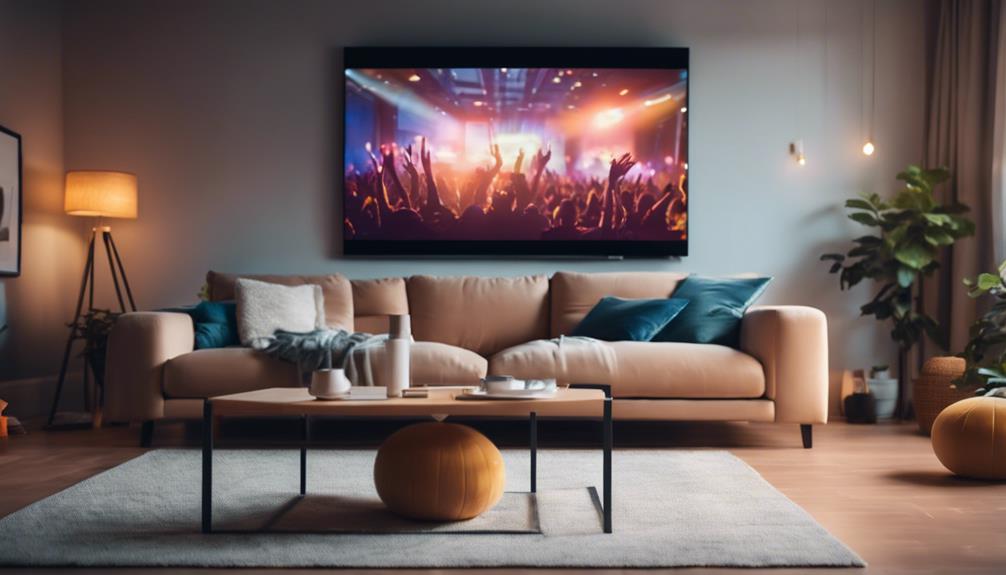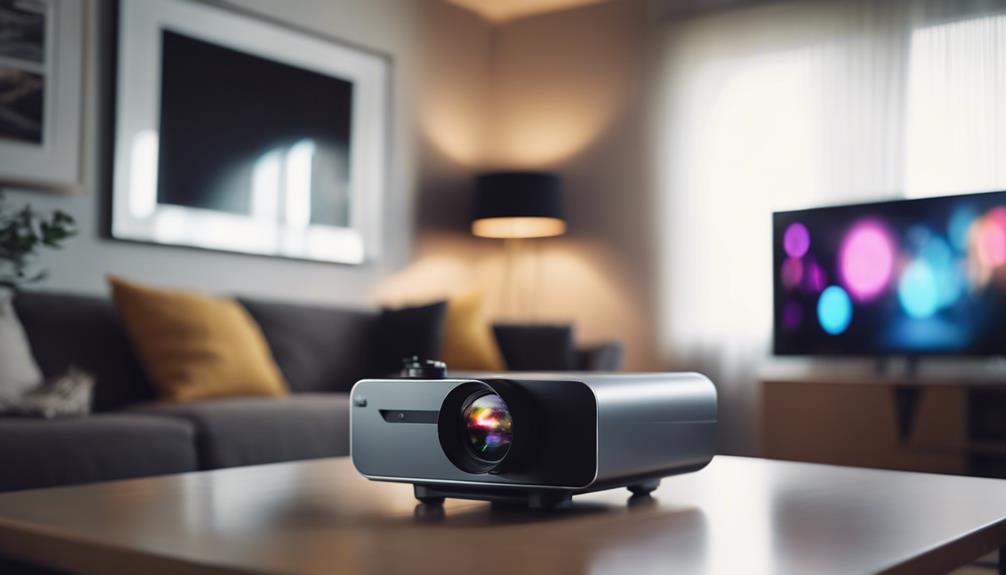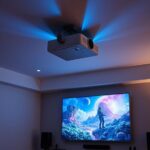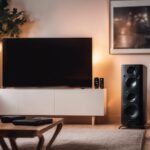To integrate a projector with smart home systems, start by selecting a compatible smart home platform, like Apple HomeKit or Google Home. Connect your projector to Wi-Fi and download relevant apps for control. Adjust picture and sound settings for peak viewing. Enhance your experience with automation features, like voice control and scheduled power management. Confirm your projector can easily connect to mobile devices and supports streaming services such as Netflix. Finally, test the setup for seamless operation across all devices. There's much more to explore in enhancing your home theater for an exciting viewing experience.
Key Takeaways
- Ensure projector compatibility with popular smart home ecosystems like Apple HomeKit, Google Home, or Amazon Alexa for seamless integration.
- Connect the projector to Wi-Fi and download necessary control or streaming apps for easy access to content and settings.
- Utilize voice control features for hands-free operation, allowing commands like "Movie time" to automate settings for an immersive experience.
- Implement smart lighting solutions that sync with projector settings to create the perfect ambiance for different viewing occasions.
Benefits of Smart Home Integration

One major benefit of integrating a projector with smart home systems is the convenience of controlling all your settings—like projection, lighting, and audio—through a single device or voice command.
With smart home integration, you can easily manage your entire entertainment setup without juggling multiple remotes or apps. This streamlined control enhances your viewing experience, making it simple to switch between streaming services or adjust the ambiance to match your movie night.
Imagine saying, "Movie time," and having your projector turn on, the lights dim, and the sound system adjust automatically. This level of voice control not only saves time but also allows you to fully immerse yourself in your content without disruptions.
Moreover, the automation features of smart home systems can optimize your environment, ensuring that your room is perfectly set up for every viewing occasion.
Whether you're catching up on the latest series or hosting a family movie night, smart home integration elevates your experience by synchronizing all elements for maximum enjoyment.
Plus, it future-proofs your setup, making upgrades simple as technology evolves.
Selecting Your Smart Home System

Choosing the right smart home system is vital for confirming seamless integration with your projector and other devices. Start by considering popular ecosystems like Apple HomeKit, Google Home, and Amazon Alexa, as they offer vast compatibility with various devices, including projectors.
When selecting your system, check the connectivity options it supports. Verify it includes Wi-Fi, Bluetooth, and HDMI to allow for seamless integration with your projector. A user-friendly interface can enhance accessibility, making it easier for all family members to operate the projector without frustration.
Don't forget to assess the expandability options of the smart home system. This will allow you to upgrade and integrate additional devices in the future, confirming long-term usability.
Research and verify the compatibility of your specific projector model with the chosen smart home system. This step is vital for guaranteeing smooth operation and taking full advantage of automated features.
Essential Components for Home Theaters

When setting up your home theater, you'll want to focus on three key components: audio system integration, lighting control solutions, and streaming device compatibility.
A great sound system makes your movie nights unforgettable, while smart lighting creates the perfect ambiance. Consider incorporating a headphone amplifier for enhanced audio clarity, especially if you're an audiophile.
Audio System Integration
Integrating a high-quality audio system transforms your home theater experience, delivering immersive sound that perfectly complements the visuals from your projector. Effective audio system integration is key to achieving this, and here are three essential components to take into account:
- Surround Sound Systems: Opt for a surround sound system to create an enveloping audio experience. This setup enhances the realism of your favorite movies and shows, making you feel like you're in the action.
- Smart Speakers: Pair smart speakers, like Amazon Echo or Google Nest, with your projector. They allow for easy voice control over audio adjustments and playback, streamlining your user experience.
- Dolby Atmos: Incorporate advanced technologies like Dolby Atmos to achieve a three-dimensional sound environment. This elevates the overall viewing and listening experience, providing a richer soundscape that draws you in.
Lighting Control Solutions
To fully enhance your home theater experience, effective lighting control solutions play an essential role in creating the perfect atmosphere for watching movies.
Automated lighting, such as smart dimmable lights and smart shades, allows you to adjust the lighting settings for ideal viewing conditions. By integrating these solutions with your smart home systems, you can set up automated scenes that dim the lights gradually or change colors to match the mood of the film.
With voice commands linked to popular smart home assistants like Amazon Alexa or Google Assistant, you can make hands-free adjustments during your movie nights. Imagine simply saying, "Dim the lights," and instantly achieving the perfect ambiance without getting up.
Additionally, consider programming your smart lighting systems to turn off automatically when the projector is in use. This not only conserves energy but also eliminates distractions, ensuring you're fully immersed in the cinematic experience.
Streaming Device Compatibility
Streaming devices like Apple TV, Fire TV Stick, and Roku are essential for connecting your projector to popular services like Netflix and Hulu, making your home theater experience seamless and enjoyable.
To fully integrate these devices and enhance your setup, consider the following:
- HDMI Cable: Make sure you have a high-quality HDMI cable to connect your streaming device to the projector. This connection guarantees peak video and audio output, creating an immersive viewing experience.
- Bluetooth Connectivity: Look for projectors that support Bluetooth. This feature allows you to connect wireless speakers or headphones, enhancing your audio experience without the hassle of wires.
- Smart Features: Opt for streaming devices with smart features. These devices let you control playback through voice commands using systems like Amazon Alexa or Google Assistant, simplifying your interaction with the projector.
Automation Features for Projectors

Smart projectors bring your home theater experience to life by seamlessly connecting with automation features that enhance convenience and ambiance. By integrating smart technology, you can control your projector and adjust settings effortlessly, giving you the ultimate viewing experience.
Here's a quick overview of key automation features for your projector:
| Feature | Benefit | Integration |
|---|---|---|
| Voice Control | Hands-free operation via Alexa or Google | Integrated into your smart home |
| Scheduled Power Management | Automatically turns on/off to save energy | Set schedules in your app |
| Dimmable Lighting Sync | Creates the perfect atmosphere for movies | Sync with smart lighting |
Initial Setup Steps

Setting up your projector for the first time is straightforward and sets the stage for an enhanced home theater experience. To begin the initial setup, follow these steps to guarantee your projector integrates seamlessly with your smart devices:
- Connect to Wi-Fi: Start by connecting your projector to your Wi-Fi network. Refer to the specific instructions for your operating system—either iOS or Android.
- Download Apps: For iOS users, download necessary apps from the App Store. Android users should access Google Play for compatible applications that help you stream content effectively.
- Adjust Settings: During the projector configuration, take time to adjust picture and sound settings. This optimization is vital for achieving the best possible viewing experience on your projector screen, especially considering your room's lighting and acoustics.
Once you've completed these steps, don't forget to test the integration with your smart home system. This guarantees seamless operation with other devices, like smart speakers and lighting, enhancing your overall entertainment experience.
Refer to the user manual for detailed guidance throughout the initial setup process.
Connecting Mobile Devices

Connecting your mobile devices to the projector opens up a world of possibilities for sharing content and enjoying a cinematic experience. With smart projectors, you can easily connect your iOS or Android devices, enhancing your streaming experience.
For iPhone and iPad users, AirPlay allows for seamless wireless streaming directly to the projector. If you have an Android device, you can utilize Miracast or Chromecast for effortless screen mirroring, displaying content without any hassle.
For those who prefer a more traditional approach, you can always go the wired route. Using an HDMI cable provides a direct connection, ensuring high-quality audio and video output from your smartphones and tablets. This method guarantees that you won't experience any lag or connectivity issues often associated with wireless options.
The flexibility of both wired and wireless connections means you can choose what works best for you. Plus, smart projectors are designed to be compatible with various mobile operating systems, making it easy for a wide range of devices to connect effortlessly.
Streaming Content With Projectors

Streaming content with projectors has never been easier, thanks to built-in access to popular services and seamless connectivity options. With modern projectors, you can enjoy a rich home theater setup without the hassle of additional devices. Here are three key ways to enhance your streaming experience:
- Built-in Streaming Services: Many projectors, like the BenQ Smart Projector, come with direct access to platforms such as Netflix and Hulu. This means you can watch your favorite shows without needing a separate device.
- Wireless Connectivity: You can easily stream content from your mobile devices using AirPlay for iOS or Miracast and Chromecast for Android. This wireless convenience lets you share videos and photos effortlessly.
- Reliable HDMI Connections: For a high-quality experience, connect your projector to laptops or gaming consoles via HDMI. This method guarantees you'll get excellent video and audio performance.
Community Resources and Support

When you're setting up your projector with smart home systems, tapping into active online communities can be a game-changer.
You'll find troubleshooting guides and DIY tutorials that help simplify the process and enhance your integration experience.
Plus, connecting with other users lets you share insights and stay updated on the latest tips and tricks.
Active Online Communities
Active online communities offer invaluable resources where you can share experiences and find solutions for integrating projectors with smart home systems. These platforms, including forums and social media groups, are great for DIY enthusiasts looking to optimize their projector integration.
By participating, you can gain insights on:
- Step-by-Step Guides: Access detailed instructions and video tutorials that simplify the integration process, helping you set up your projector seamlessly with your smart home devices.
- Brand-Specific Threads: Find discussions focused on specific projector brands and models, making it easier to get targeted advice tailored to your equipment's features and compatibility.
- Firmware Updates and Best Practices: Engage in conversations about the latest firmware updates and best practices, ensuring your integration remains smooth and efficient over time.
Troubleshooting Guide Resources
How can you effectively troubleshoot projector integration issues in your smart home system?
Start by exploring community resources that can provide valuable insight and support. Online forums, like Reddit and dedicated tech sites, often host discussions where users share their experiences and troubleshooting tips for integrating projectors with smart home systems. You can post your specific problems and benefit from the expertise of experienced members.
Don't forget to check the support resources provided by manufacturers. Many offer FAQs, user manuals, and video tutorials that address common integration issues. These can guide you through troubleshooting steps and help you understand how to better integrate your projector.
Additionally, active social media groups focused on smart home technology can be a fantastic platform for collaboration. Engage with other users to exchange advice and solutions.
Lastly, regularly checking for firmware updates and compatibility notes from both your projector and smart home system manufacturers can prevent many issues and enhance overall functionality. By using these resources, you can tackle troubleshooting head-on and guarantee seamless integration of your projector into your smart home system.
DIY Automation Tutorials
Exploring DIY automation tutorials can empower you to seamlessly integrate your projector with your smart home system while leveraging community support and resources. These tutorials offer practical insights and step-by-step guidance, making your automation process smoother.
Here are three valuable resources to evaluate:
- Community Forums: Engage with fellow DIY enthusiasts on platforms like Reddit or specialized forums. You'll find discussions on specific projector models and their compatibility with smart home systems, plus troubleshooting tips.
- YouTube Tutorials: Visual learners can benefit from YouTube, where numerous creators showcase how to automate your projector using various smart home hubs. These videos often include real-life examples that simplify complex setups.
- Dedicated Blogs: Many websites offer thorough guides on creating automation scripts to control your projector alongside other smart devices. You can learn how to use your smartphone app effectively, enhancing your overall smart home experience.
Frequently Asked Questions
How Do I Add a Projector to My Home Assistant?
To add a projector to your Home Assistant, make certain it's Wi-Fi or Bluetooth compatible. Then, use the integration platform to connect and configure settings, allowing you to control it through the app or voice commands.
Can You Connect a Smart TV Box to a Projector?
Yes, you can connect a smart TV box to a projector using an HDMI cable. Just plug it in, switch to the correct input, and enjoy streaming your favorite shows on the big screen!
Conclusion
Integrating your projector with smart home systems transforms your viewing experience from ordinary to extraordinary.
Imagine dimming the lights with a voice command, creating a cozy atmosphere for movie night, while effortlessly streaming your favorite content.
You'll enjoy the convenience of automation, yet still relish the tactile joy of clicking a remote.
So, embrace the future of entertainment—where technology enhances comfort, and every film feels like a cinematic event right in your living room.
Hello, I’m Art, and I’m excited to be a part of the 1Home Theatre Projector team. As a writer, I’m here to contribute my knowledge and insights to help you achieve the ultimate home cinema experience. I understand that making decisions in the world of home entertainment can be complex, and I’m here to simplify the process for you.
















